With just 4 ingredients, this strawberry rhubarb jam is versatile!
Serve it with English muffins, overnight oats, pancakes, ice cream, homemade bread!
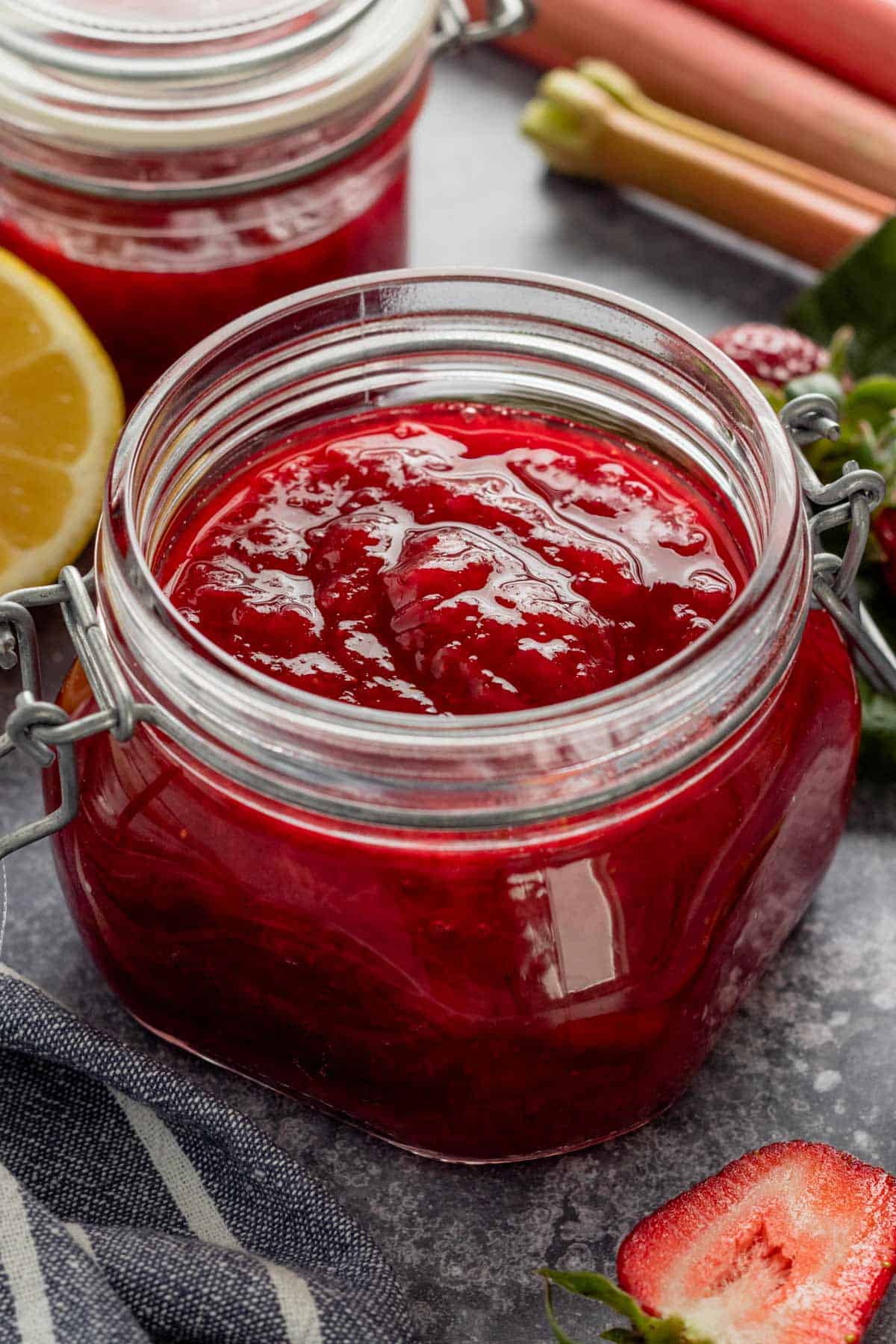
Got more rhubarb? Make this strawberry rhubarb crisp and 5 ingredient rhubarb oatmeal cookies next.
Jump To
Ingredients
- Strawberries - hull the strawberries and cut the larger berries in quarters and smaller ones in half.
- Rhubarb - you can also make rhubarb jam without strawberries by increasing the rhubarb amount (+1 pound of rhubarb).
- Lemon juice - freshly squeezed! Bottled lemon juice should only be used as a last resort. Lemon zest is ok.
- Just like my banana jam, this rhubarb jam has no pectin added.
Rhubarb naturally contains some pectin, and when cooked with sugar, the jam attains a well-gelled consistency.
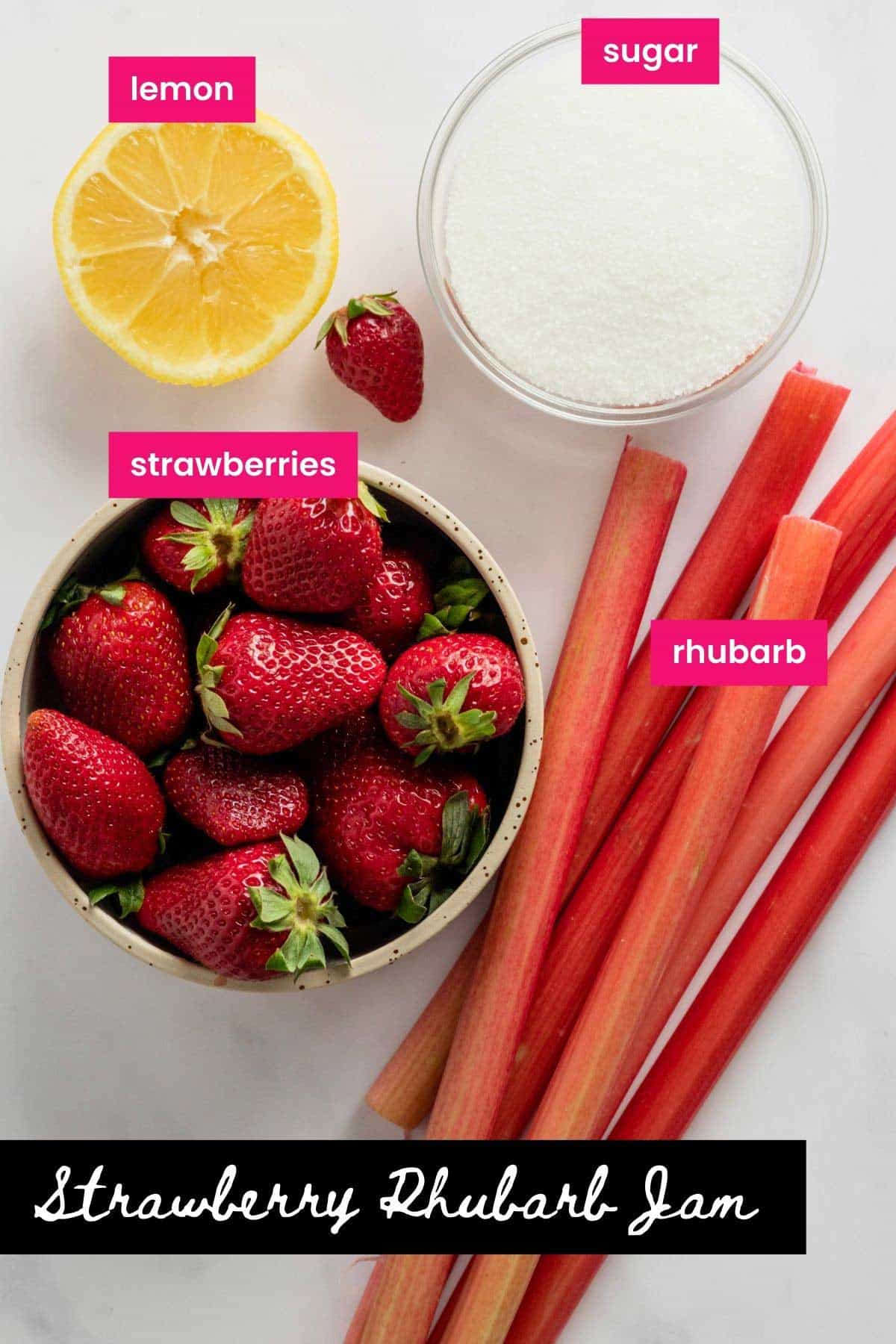
Identify ripe rhubarb by choosing long, firm stalks, disregarding the color as it indicates the variety, not ripeness. Ensure the leaves are undamaged.
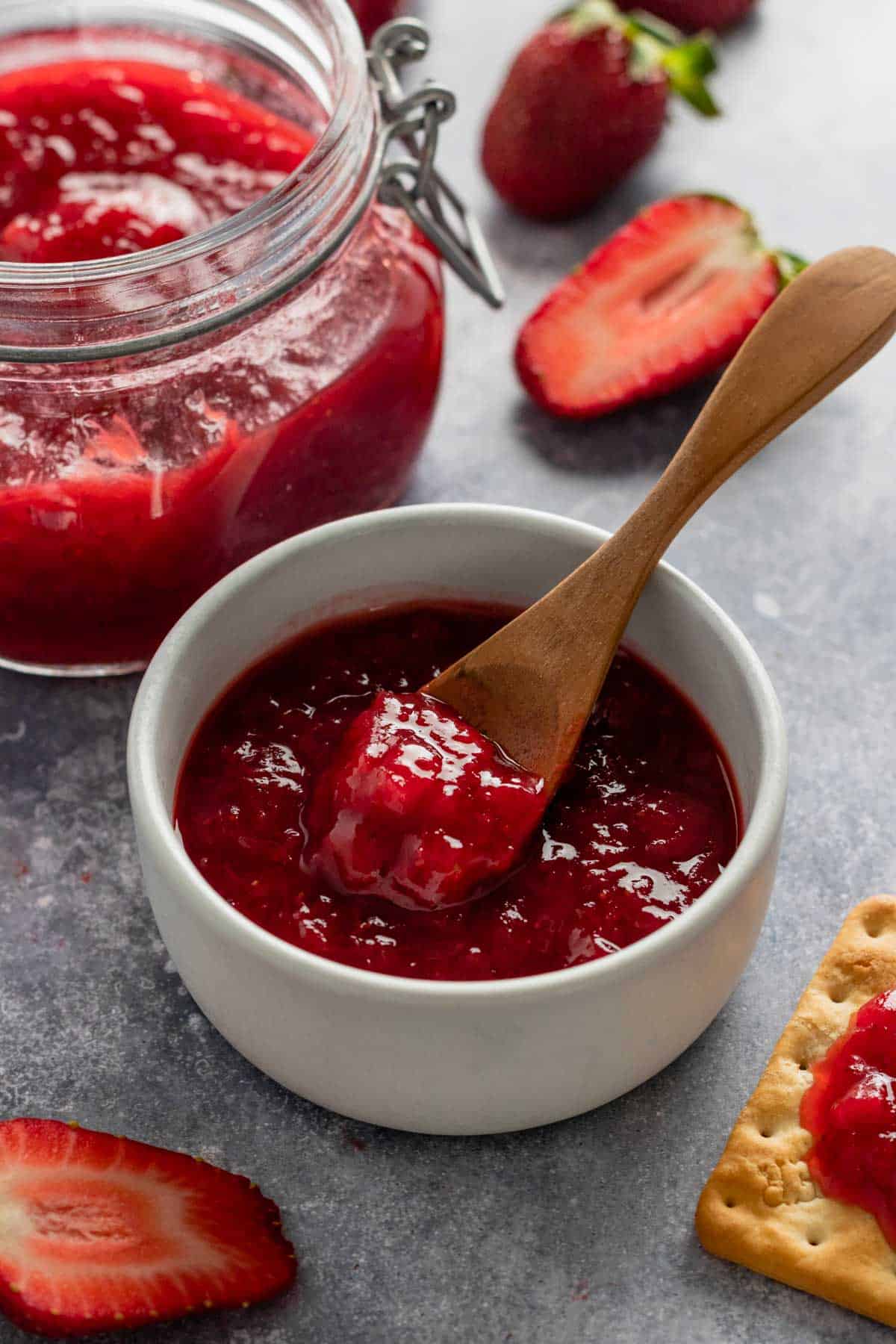
My few comments on the ingredients + don't forget to read the Tips section!
The full recipe and ingredients can be found in the recipe card below this post.
How To Make Strawberry Rhubarb Jam
Prepare half-pint jars by boiling the lids, rings and jars in boiling water for 5 minutes.
This is known as the water bath canning method.
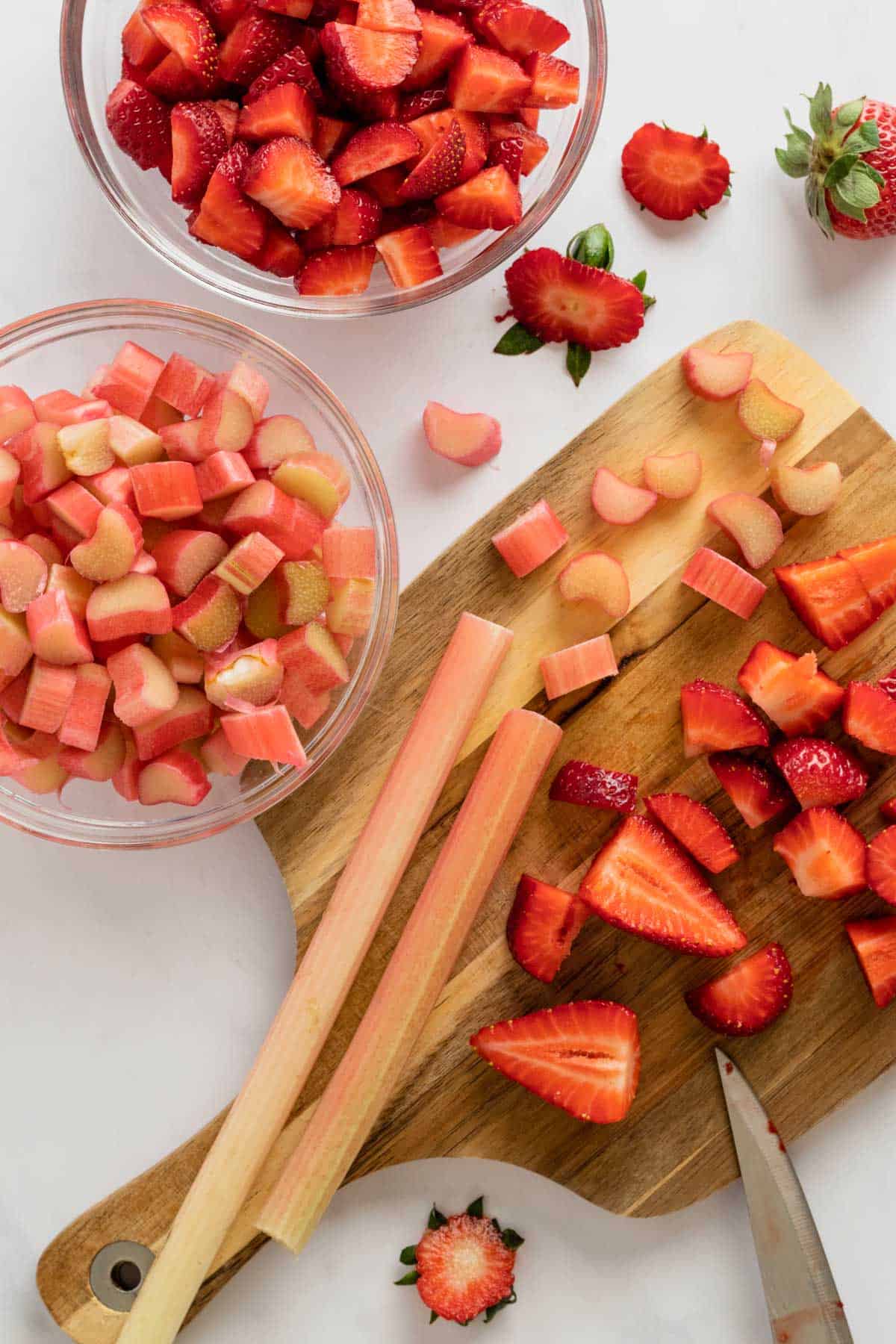
Slice the strawberries into small chunks.
You could also use a potato masher to reduce the size of the fresh berries.
For hulling strawberries, my preferred method is the 2-step slit-and-core technique, removing the tops and then the core.
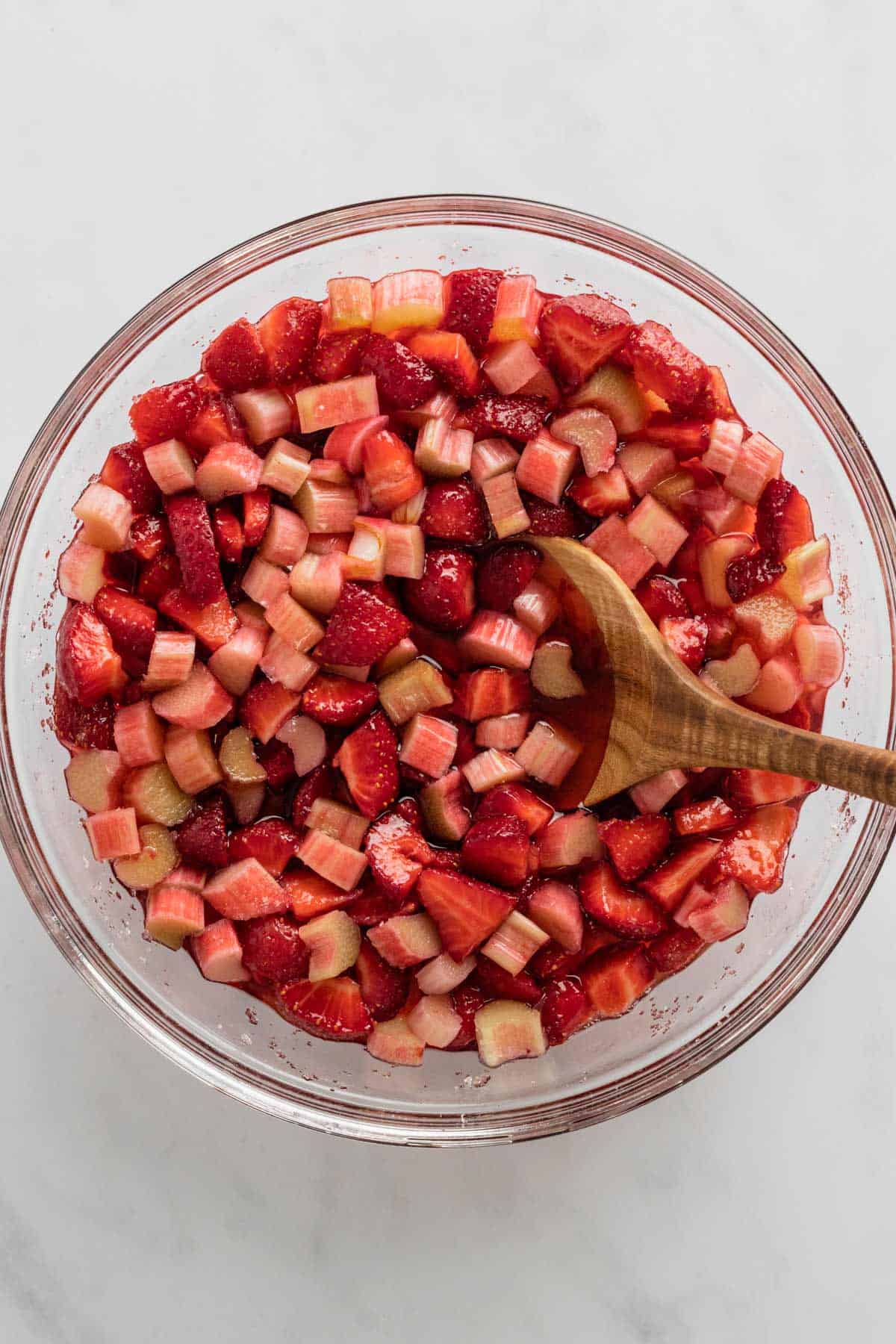
To minimize waste, I repurpose the tops for refreshing flavored water or strawberry iced tea, providing a pleasant fruity flavor to my drinks.
Cut the rhubarb into small chunks, approximately half an inch in size.
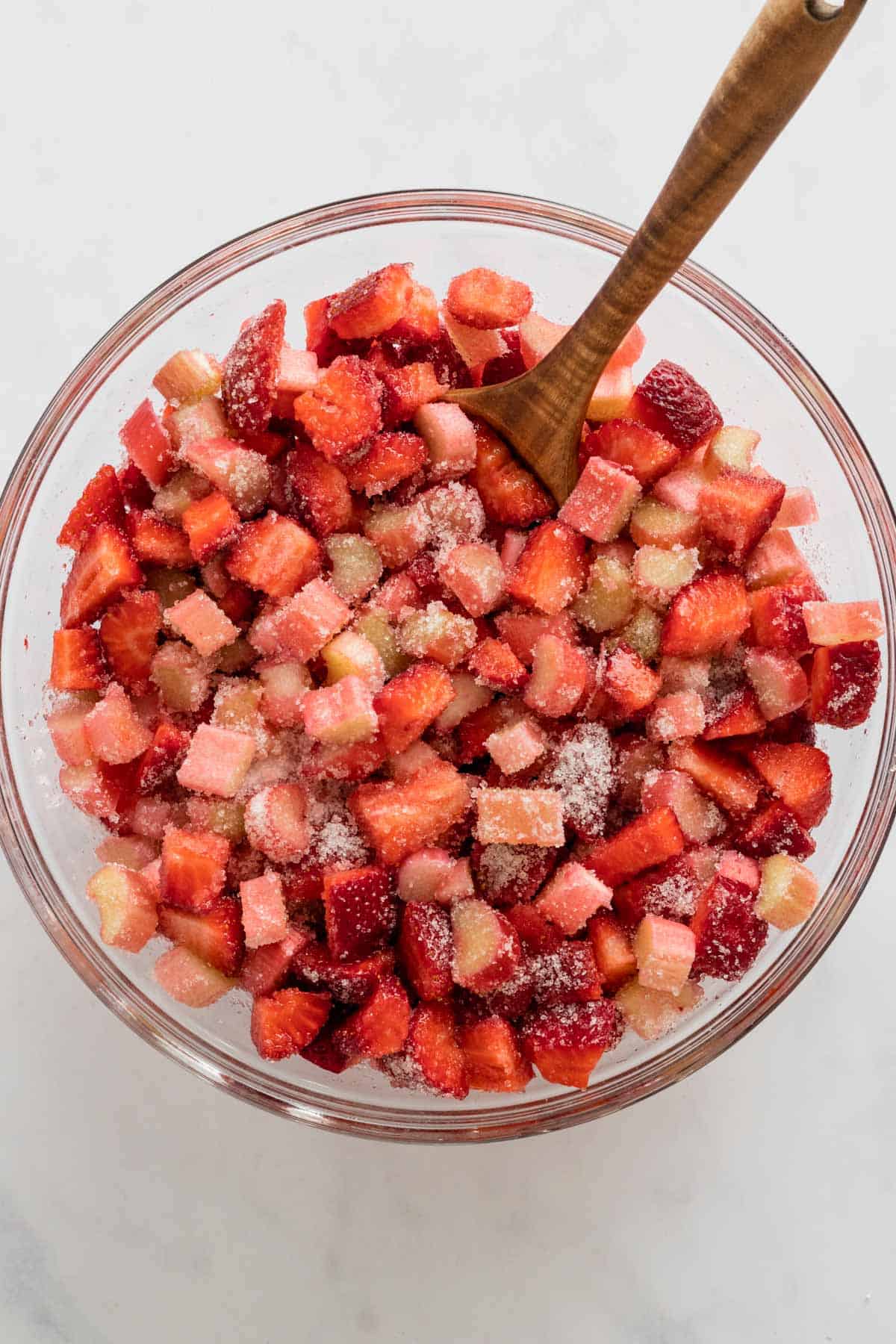
Next, grab a glass bowl and combine the chopped strawberries, rhubarb, and sugar.
Give it a good mix and let it sit for about an hour. This allows the flavors to mingle and develop.

After an hour, transfer the fruity mixture to a wide saucepan. Stir continuously over medium heat until it gently boils.
While cooking, you might notice some foam forming on the surface; simply scoop it out with a spatula.

Keep stirring until the mixture thickens. Stirring constantly is essential to avoid burning and splattering.
This process will likely take around 20 minutes or more.

5 minutes before the end of cooking, add the lemon juice and stir well. Remove from the stovetop.
To check if the jam is ready, use a spoon to create an open trail behind it as you stir.
Once the mixture reaches this thickness, you'll know it's done. Refer to the tips section for more guidance.
Once cooled, pour into jars.
This recipe makes 2 ⅓ cups of jam.
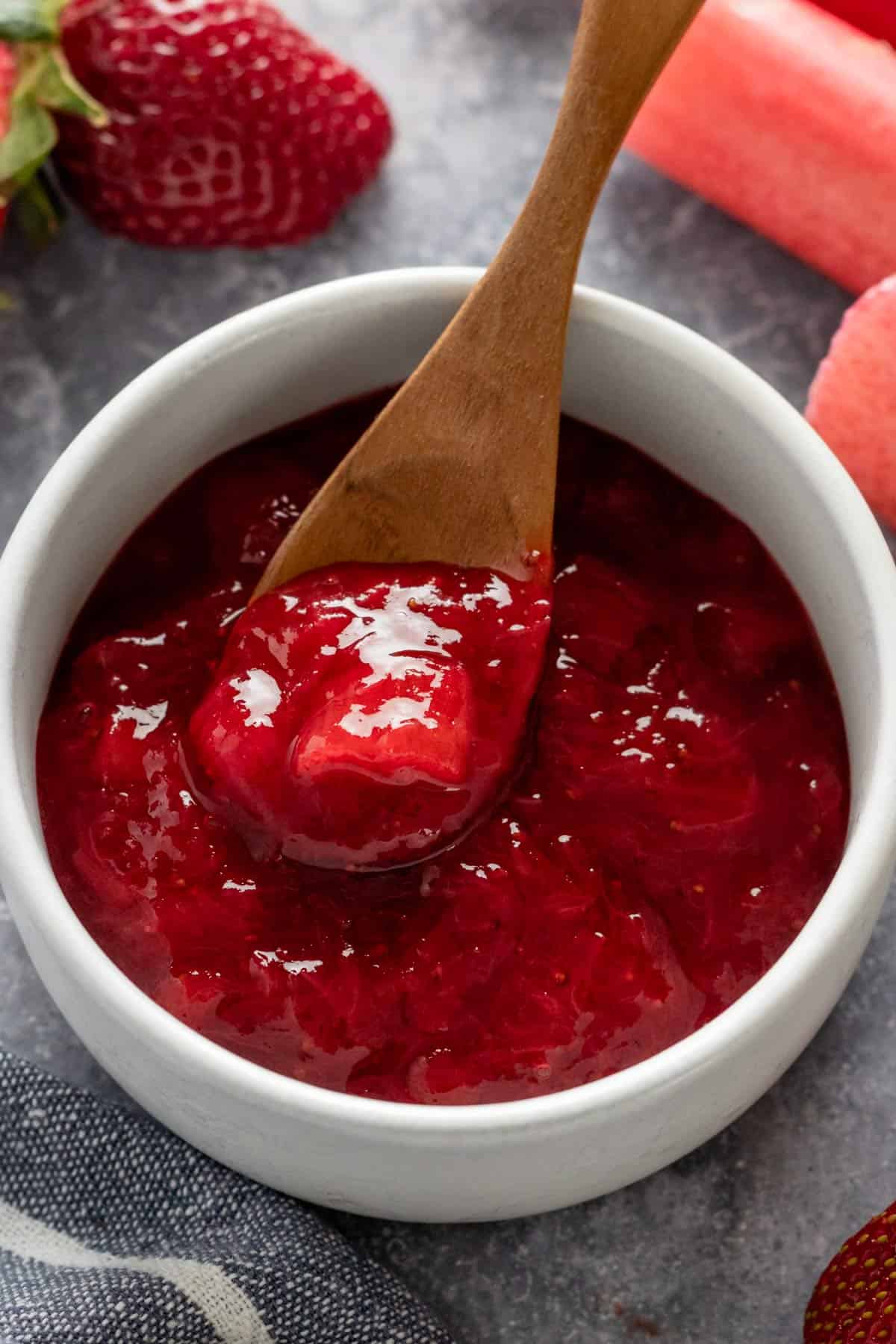
Confirm jam readiness by dragging a spoon through it, leaving behind an open trail. Alternatively, place a small amount in the fridge for a minute, then check stickiness and a visible trail with your finger.
Tips
- Flavor. It may change every time you make the jam as this will vastly depend on the ripeness of the strawberries and rhubarb.
- Lemon juice not only balances the jam's sweetness but also serves as a natural preservative, preventing mold in each mason jar.
- Cooking the jam in a wider saucepan will speed up the evaporation of moisture in the jam while cooking.
- Wash strawberries before stemming to avoid excess water absorption.
- Use fresh and ripe strawberries, rhubarb, and lemon juice for optimal results. Remove tough fibrous strings from rhubarb before chopping.
- Cook the jam on a gentle boil, stirring constantly to prevent burning and allowing the fruit's natural pectin to thicken the mixture.
- Sterilize jars and lids in a hot water bath for an extended shelf-life and to prevent bacterial growth in this easy strawberry rhubarb jam.
- No need to peel the rhubarb. When using rhubarb in baking, keep the vibrant red or pink stalks and discard the leaves. There's usually no need to peel the thin and tender skin, but remove any tough strings with a vegetable peeler if necessary.
- Ensure ripe rhubarb for baking by selecting long, firm stalks, as the red color is not necessarily an indicator of ripeness—it denotes the variety. Check that the leaves are undamaged.
Removing foam while cooking is crucial for a visually appealing jam, free from debris and ensuring even cooking.
Benefits of Making Your Own Jam
There are plenty of great benefits to making your own jam, including:
- The use of healthy ingredients. Making your own jam gives you full control over the ingredients used.
- No Pectin - We don't add pectin to our jams as we find that using just fresh plants and sugar is more than enough. It is true, that additional pectin gives the jam a more pleasing thickened ''jelly-like'' texture, and this normally will have a small effect on the flavor.
- Better flavor and texture - Using fresh fruit to make your own jam will boost the flavor and texture of the jam.
- It’s great for the budget. Homemade jam is usually always more cost-effective than commercial jam, especially if you have bought ingredients in bulk to make larger batches of jam. You also won’t be paying for the packaging and branding of commercial jams.
- 🌎Reduces waste. Making homemade jam from extra strawberries and rhubarb in your garden or kitchen is a great way to eliminate food wastage.
- Support local businesses. Making homemade jam from local seasonal produce can help support small businesses and farmers in your area!
How To Serve Rhubarb Jam
- Savory. As a glaze for roasted meats or as a snack with cheese and crackers. Try my Baked Camembert recipe and use this jam instead of blueberries and honey.
- Baking. In thumbprint cookies, sweet pies, rice pudding, tarts, and pastries, buttery biscuits or enjoy it as a topping over pancakes, ice cream or yogurt.
- As a breakfast spread over toast and bagels, or stir it into oatmeal or yogurt + granola.

📋 JULIA'S TIP: Unfortunately, many fruits and veg can be contaminated with pesticides. For this reason, it is recommended to switch to as much organic produce as possible.
Freezing and Storing Instructions
- To Store. Let the jam cool before transferring to jars. Seal the lids tightly and keep them refrigerated (will last for about 4-6 months) or at room temperature, but once opened should be kept in the refrigerator.
- The longevity of the jam will depend on how it is stored, how many times opened, and if used a clean spoon to scoop out the jam for serving.
- To Freeze. This jam can be stored in the freezer as a freezer jam, but then I recommend that you leave 1-inch headspace between the jam and the jar lid for expansion during freezing.
📋If you have extra fruit, you can make these gluten free rhubarb recipes: strawberry rhubarb crisp and rhubarb oatmeal cookies.
Variations
- Spices. Add warmth and depth of flavor to this strawberry rhubarb jam by including spices such as cinnamon, nutmeg, or ginger.
- Sweeten the jam with honey instead of granulated sugar. Or sweeteners can be used but flavor will change and only use it if you are used to flavor, and know the conversions.
- Vanilla. Add vanilla bean to the jam for a subtle vanilla flavor infused throughout the jam.
- Fresh orange juice could be used instead of lemon juice for a touch of citrus flavor and to balance out the sweetness in the jam.
- For more jam recipes, try my Berry Banana Jam, Mixed Berry Sauce or Lingonberry Sauce recipes.
I would appreciate it so much if you left a comment about this recipe below! Subscribe to join the TYB newsletter and receive free recipes straight to your inbox! Let's connect via Facebook, IG & Pinterest!
Recipe

Strawberry Rhubarb Jam
INGREDIENTS
- 1 pound strawberries, about 3 heaping cups, chopped
- 1 pound rhubarb, about 3 heaping cups, chopped
- 1 ½ cups sugar
- 3 teaspoon lemon juice, freshly squeezed
INSTRUCTIONS
- Prepare half-pint jars by boiling the lids, rings and jars in boiling water for 5 minutes. This is known as the water bath method.
- Slice the strawberries into small chunks. You could also use a potato masher to reduce the size of the fresh berries.
- Cut the rhubarb into small chunks, approximately half an inch in size.
- Next,in mixing bowl combine the chopped strawberries, rhubarb, and sugar. Give it a good mix and let it sit for about an hour. This allows the flavors to mingle and develop.
- After the hour is up, transfer the fruity mixture to a wide saucepan, large pot, or skillet. Keep stirring constantly as you cook it over medium heat until it starts gently boiling. While cooking, you might notice some foam forming on the surface; simply scoop it out with a spatula.
- Continue cooking and stirring until the mixture thickens. It's crucial to stir constantly to avoid burning the jam, and it also helps to prevent any splattering. This process will likely take around 20 minutes or more. 5 minutes before the end of cooking stir in the lemon juice.
- To check if the jam is ready, use a spoon to create an open trail behind it as you stir. Once the mixture reaches this thickness, you'll know it's done. (See pictures in the blog post)
- Remove the saucepan from the heat and allow the jam to cool completely before serving.
- Now, it's time to enjoy your homemade jam!
NOTES
- This recipe yields 2 ⅓ cups of jam which makes about 16 servings if using 2 or 2 ½ tablespoons per serving.
- Removing the foam from the top of the jam mixture while cooking is essential to get a beautiful-looking jam free from debris from the fresh chopped fruit. It also helps the jam cook evenly.
- The lemon juice balances the sweetness in the jam and acts as a natural preservative, combating mold from occurring in each mason jar.
- Cooking the jam in a wider saucepan will speed up the evaporation of moisture in the jam while cooking.
- Use fresh and ripe strawberries, rhubarb, and lemon juice for the best results.
- Remove any tough fibrous strings in the rhubarb before chopping it. You don’t want these in this in your jam.
ADD YOUR OWN PRIVATE NOTES
NUTRITION
Note: Nutrition information is estimated and varies based on products used.
Full Nutrition Disclaimer can be found here.
Common Reader's Questions
Strawberry and rhubarb are a popular combination of flavors, offering that perfect balance of sourness and sweetness as well as complexity of flavor.
While rhubarb is low in pectin, the addition of strawberries and lemon juice contributes enough to make this jam naturally soft and luscious, eliminating the need for additional pectin.
Accurate ingredient measurements are crucial to avoid runny jam. Without added pectin, this jam won't be overly thick, but careful slow cooking over medium heat, with constant stirring, ensures it doesn't become too runny.
Yes, lemon juice not only balances sweetness but also provides a natural pectin boost to this jam recipe, eliminating the need for added pectin.
Strawberries have a tough inner core which needs to be removed, especially when you are making jam where the right texture matters.
Easy! Trim and slice rhubarb, sprinkle with sugar, let sit for an hour. Simmer in a saucepan until boiling and thickened, removing foam. Test readiness by stirring with a spoon to create an open trail. For details and tips, refer to the recipe card for this strawberry rhubarb jam.
No, rhubarb plants are dangerous for dogs. If your dog eats them, it can cause poisoning because of the oxalic acid in the plant.
Store unwashed rhubarb stalks in the refrigerator for 2-3 weeks. For optimal storage, keep them unwashed as washing accelerates rot. Freeze rhubarb in an airtight container for up to 6 months; cut into smaller chunks before storing.
Strawberry Recipes
Or for all sweet recipes, hop on to our Desserts collection.


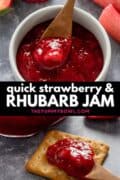
Julia | The Yummy Bowl
Just 4 ingredients to make this yummy homemade rhubarb jam and serve over pancakes, in thumbprint cookies, or simply enjoy it with ice cream and yogurt.
Pam
When do I add the lemon juice? It mentions it in ingredients and tells the benefit but do we add it to our mix before or after cooking?
Julia | The Yummy Bowl
Hi Pam! Sorry for that, I will fix it right away. Lemon is added 5 minutes before the end of cooking.
Georgie Lewis
How many jars will I need ?
Julia | The Yummy Bowl
This recipe makes 2 ⅓ cups and you'd need about 2 half pint jars